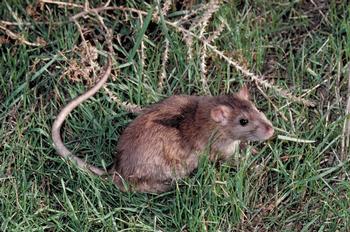Who’s stealing my fruit or veggies – rats or raccoons – and what can I do about them?
-
Julie McMillan
-
You’re ready to harvest your fruit or veggies, but discover someone has stolen them, or taken a bite! Who’s doing this: rats or raccoons? And what can you do to control them?
First, determine which pest is doing the damage.
Rats leave comma-shaped droppings (about ¾” long) and are nocturnal. Marin has two kinds of rats: Norway and roof. If you see this, then you have burrowing Norway rats. Photo: Jack Kelly Clark, UC Regents.
If you see this, then you have burrowing Norway rats. Photo: Jack Kelly Clark, UC Regents.Norway rats, also called brown or sewer rats, burrow along building foundations, beneath rubbish or woodpiles, and in moist areas in gardens. They memorize pathways and locations for food and water. Norway rats weigh 7-18 ounces, and eat a variety of foods, preferring grains, meats, fish, nuts and some fruit.
Roof rats, also called black or tree rats, are agile climbers and usually nest above ground in shrubs, trees (especially palms), and dense vegetation. They have tails longer than their heads and bodies combined, and weigh only 5-10 ounces. Roof rats eat many types of foods, preferring fruit often still on the tree (citrus and avocados are favorites), nuts, berries, slugs and snails.
Raccoons, also nocturnal, are 2-3 feet long and weigh between 7-30 pounds. They can be vicious when cornered. Raccoons den in hollow trees, ground burrows, brush piles, rock crevices, storm drains, and beneath decks. Look for evidence of raccoon tracks and droppings (dark and tubular with a pungent odor and around 3” long). Listen for noise on your roof and in your chimney or attic. Raccoons like to roll up turf or destroy lawns looking for worms and grubs. They eat plants and animals, including berries, nuts, acorns, corn (a favorite), pet food, birdseed, snails, insects, koi fish, chickens and eggs. Raccoons like to wash their food, called “dousing.”
To control these pests, take the following steps:
Rat populations increase quickly with available shelter, food, and water. Eliminate potential hiding and nesting sites. Clean up dense ground covers (especially ivy, pampas grass and bamboo) and shrubbery, firewood and debris. Harvest early and pick up fallen fruit and vegetables. Rats are attracted to odors from outdoor grills, pet food bowls and garden waste, including compost piles. Keep these areas clean and away from where you grow fruit and vegetables. Collect garbage, trash and garden debris frequently, and use tight-fitting lids for your trash cans. If you have a bird feeder, make sure bird food doesn’t fall on the ground; use feeders with trays to reduce spilling. You may want to attract barn owls, who prey on rats (and mice, voles and gophers), by installing a nest box. If you have burrowing Norway rats creating underground tunnels and nests, you may need a professional exterminator. While trapping is generally recommended indoors, when you have rats outside, you may need professional help. If you see this, then you have roof rats. Photo: Jack Kelly Clark, University of California Statewide IPM Program
If you see this, then you have roof rats. Photo: Jack Kelly Clark, University of California Statewide IPM ProgramFor raccoons, follow the sanitation steps above. In addition, store your trash cans in a rack or tie them to a post to prevent raccoons from tipping them over. Trim back tree branches, creating a gap between your roof and trees (ten feet is recommended to create defensible space for wildfires). Relocate trellises attached to your home to limit roof access. If you have a fountain, you may want to remove it to prevent dousing, or after the drought ends, consider installing one with steep instead of sloping sides, dropping to a foot or more. Covering your fountain each night with a heavy screen also helps. If you have chickens, secure them before sundown. Raccoons can dig under or climb over ordinary fences. Electrified fences may be effective; to ensure they’re safe, consult a professional. And if you want to try to trap a raccoon, enlist a wildlife control officer.
To learn more about controlling rats, please visit http://ipm.ucanr.edu/PMG/PESTNOTES/pn74106.html; for raccoons, http://ipm.ucanr.edu/PMG/PESTNOTES/pn74116.html


